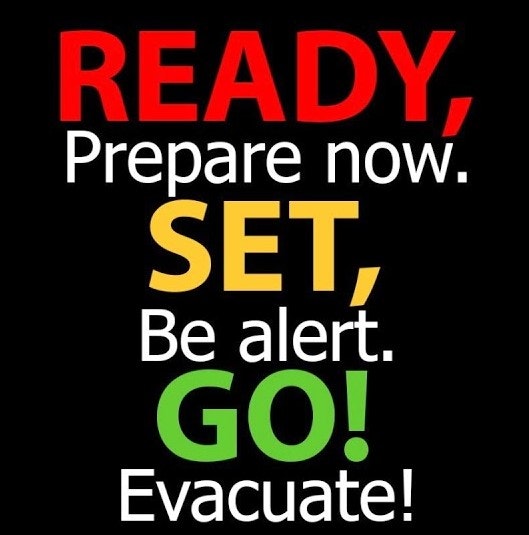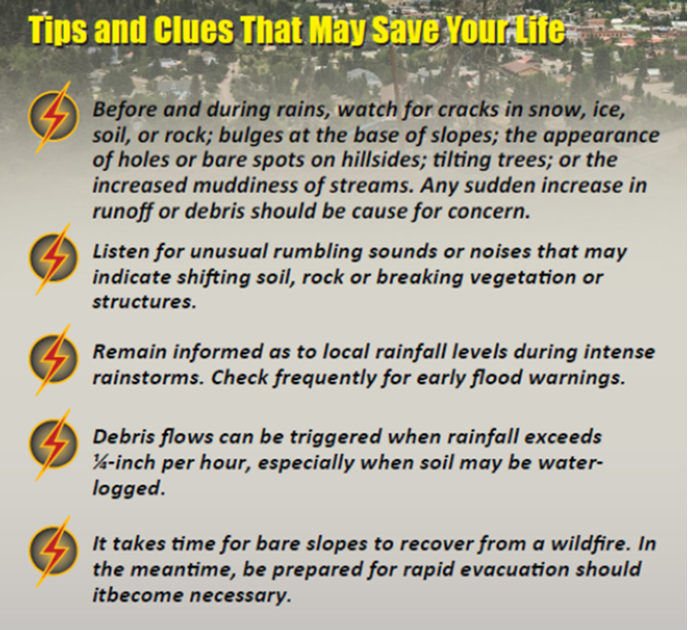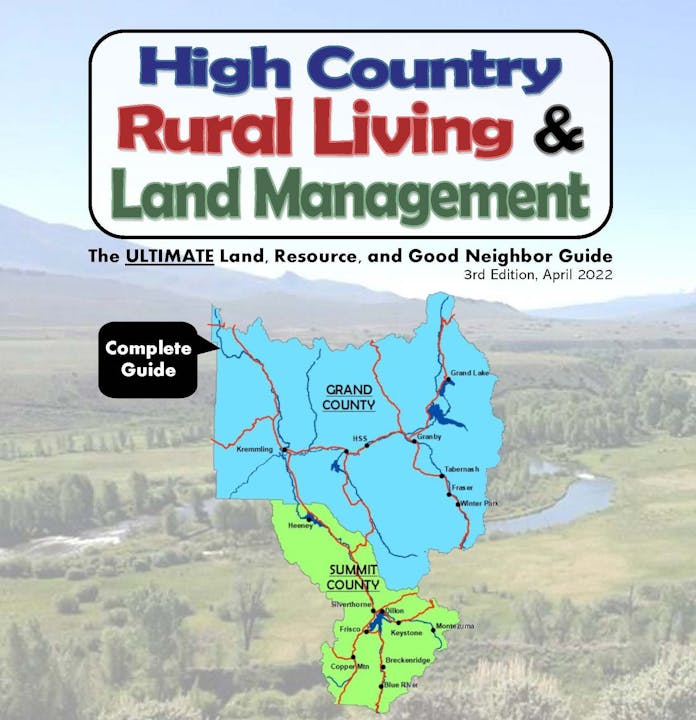Mitigating for Wildfire 3

ON THIS PAGE
- Creating a Wildfire Action Plan
- Ready – Get Your Property & Family Ready
- Set – Situational Awareness When a Fire Starts
- Go! – Act Early
- A Wildfire is HERE! Now What?
- Insights from a Wildfire Survivor
- Ranchers & Livestock Owners - Wildfire Planning
- Post-Fire Recovery Resources & Threats
- For more topics on wildfires, visit Mitigating for Wildfire 1 & Mitigating for Wildfire 2
Creating a Wildland Fire Action Plan
When a fire sparks, your adrenaline gets pumping, reasonable thought processes get frazzled, and everything gets a bit frantic. In order to avoid some initial confusion spurred by the news of an approaching fire, you and the members of your household SHOULD be prepared well in advance.
Use these checklists to help devise your own unique Wildland Fire Action Plan. Each family’s plan will be different. Once your plan is complete, rehearse it regularly, and keep it in a safe and accessible place for quick implementation.
Ready – Get Your Property & Family Ready
- Sign up for CodeRED to receive emergency alerts (Need to Know section).
- Install a 9-1-1 Reflective Address Sign at the end of your driveway or on your house if your house is on the main thoroughfare.
- Have tools, such as a shovel, rake, bucket, and hoe, available for fire emergencies.
- Install smoke alarms on each level of your home, inside and outside of all bedrooms. Test them monthly and change the batteries twice a year. Train your family how to use them.
- Ensure that your family knows where your gas, electric, and water main shut-off controls are and how to use them.
- Plan several different evacuation routes.
- Designate an emergency meeting location outside the fire hazard area.
- Assemble an emergency supply kit for you and your pets.
- Appoint an out-of-area friend/relative as a point of contact so you can communicate with family members who relocate.
- Maintain a list of emergency contact numbers posted near your door and in your emergency supply kit.
- Keep an extra emergency supply kit in your car in case you can’t get to your home because of fire.
- Make sure you account for the evacuation of large animals, such as horses or cattle, in your Wildland Fire Action Plan.
- Especially if a second homeowner, consider getting a Knox Rapid Access System/Padlock for faster access to your driveway / home by first responders.
Set – Situational Awareness When a Fire Starts
- Evacuate as soon as you are set! Don’t wait!
- Alert family and neighbors so they know you have left your home. Leave a note on the door and, if you can, place a bright white item visible in a window indicating you have evacuated.
- Dress in appropriate clothing (i.e., clothing made from natural fibers, such as cotton, and work boots). Have goggles and a dry bandana or particle mask handy.
- Ensure that you have your emergency supply kit on hand. It should include all necessary items, a battery-powered radio, spare batteries, emergency contact numbers, and ample drinking water (see Emergency Supply Kit on below).
- Stay tuned to your TV or local radio stations for updates.
- If you are not ready to leave, remain close to your house, drink plenty of water, and keep an eye on your family and pets.
INSIDE CHECKLIST
- Shut all windows and doors, but leave them UNLOCKED.
- Shut off gas at the meter. Turn off pilot lights.
- Leave interior lights on so firefighters can see your house under smoky conditions.
OUTSIDE CHECKLIST
- Gather up flammable items from the exterior and bring them inside or away from home.
- Turn off propane tanks.
- Do NOT leave sprinklers on or water running - it can waste critical water pressure.
- Leave exterior lights on.
- Back your car into the driveway, shut the doors, and roll up the windows.
- Have a ladder and garden hoses available for firefighters.
- Seal attic and ground vents with precut plywood or commercial seals (only if time permits).
- Patrol your property and extinguish all small fires until you leave.
IF YOU ARE TRAPPED: SURVIVAL TIPS
- Shelter away from outside walls.
- Bring garden hoses inside the house so embers don’t destroy them.
- Patrol inside your home for spot fires and extinguish them.
- Wear long sleeves and long pants made of natural fibers, such as cotton.
- Stay hydrated.
- Ensure you can exit the home if it catches fire (REMEMBER... if it is hot inside your home, it is 4-5 times hotter outside).
- Fill sinks and tubs for an emergency water supply.
- Place wet towels under doors to keep smoke and embers out.
- After the fire has passed, check your roof and extinguish any fires, sparks, and embers.
- Check inside the attic for hidden embers.
- Patrol your property and extinguish small fires.
- If there are fires that you cannot extinguish with a small amount of water or in a short period of time, call 9-1-1.
Go! – Act Early
By leaving early, you give your family the best chance of surviving a wildfire. You also help firefighters by keeping roads clear of congestion, enabling them to move more freely and do their job in a safer environment.
When to Leave
Leave early enough to avoid being caught in fire, smoke, or road congestion. Do NOT wait to be told by authorities to leave. In an intense wildfire, authorities may not have time to knock on every door. If you are advised to leave, do NOT hesitate! If you receive an emergency notification call, LISTEN carefully to the message and follow the directions given.
Where to Go
Leave to a predetermined location (it should be a low-risk area, such as a well-prepared friend or relative’s house, a Red Cross shelter or evacuation center, hotel, etc.). If an Evacuation Center has been stood up, go there to let them know you are safe.
How To Get There
Know MULTIPLE travel routes out of your community in case one route is blocked by wildfire or emergency vehicles. Choose the safest route away from the fire.
What to Take
Take your emergency supply kit containing your family’s and pet’s necessary items. The American Red Cross recommends every family have an Emergency Supply Kit assembled long before a wildland fire or other emergency occurs. Use the list below to help assemble your kit. You can also check out www.redcross.org.
Emergency Supply Kit
- Three-day supply of water (one gallon per person per day)
- Three-day supply of non-perishable food for all family members and pets
- First aid kit and sanitation supplies
- Flashlight, battery-powered radio, and extra batteries
- An extra set of car keys, credit cards, and cash
- Extra eyeglasses, contact lenses, prescriptions, and medications
- Map marked with evacuation routes
- Important family documents and contact numbers
- Easily carried valuables, family photos, heirlooms, and other irreplaceable items
- Personal electronic devices
- Chargers for electronic devices (cellphones, laptops, iPads, etc...)
- A pair of old shoes and a flashlight in a handy spot in case of sudden evacuation at night
A Wildfire is HERE! Now What?
For map and info on current wildfires, visit inciweb.nwcg.gov/
For a map and info on smoke and air quality, visit fire.airnow.gov/
MAP - Grand County Evacuation Zones
Initial Actions
After the initial pre-evacuation or evacuation of your property, your endorphins will be running on high and you may be in some state of shock, panic, confusion, and distress. Consequently, you may not think of all the things you should do after the fire.
- Call, text, or use social media to let friends and family know you are okay.
-
Check the jurisdiction’s website and social media accounts to determine if they have set up an Evacuation Center or Disaster Assistance Center (DAC).
- If you were evacuated, it may be imperative that you check in with the Evac Center to let them know you have evacuated and how you can be reached. They may also have resources on shelters.
Grand County Emergency: www.gcemergency.com/
Summit County Emergency: summitcountyco.gov/96/Emergency-Management
Sign up for CodeRED Notifications if you have not already done so.
Grand County: www.gcemergency.com
Summit County: summitcountyco.gov/1149/Summit-County-Alert
- Limit wildfire smoke exposure and keep an eye out for air quality advisories.
- Pay attention to any community meetings that may be held.
- DO NOT GO AROUND, MOVE, OR OTHERWISE BYPASS BARRICADES AND CLOSURES. They are there for your safety.
Next Steps
- Contact your insurance agent and mortgage company to let them know what happened, where you are, and how you can be reached.
- Keep ALL receipts. Out-of-pocket expenses during a mandatory evacuation are reimbursable under most standard homeowner policies.
- Prepare a detailed inventory of everything in your house so that you can verify upon reentry whether it was damaged or not. Make two copies; one for yourself and one for the insurance adjuster. Your list should be as complete as possible, including a description of the items, dates of purchase or approximate age, cost at time of purchase and estimated replacement cost.
- Determine what important documents were lost and begin replacing them (passport, ID, credit cards, birth certificate, will and living will, the itinerary and plane tickets for your next vacation).
Returning Home
- Do not return to your home until it is declared safe by local authorities. Injury is very common after a disaster when returning home because of debris, sharp objects, and unstable structures. Protect yourself by wearing eye protection, a mask, sturdy boots, long sleeves, long pants and gloves when returning home and cleaning up.
- Heed warnings from officials about boil water orders, food safety, debris and hazardous material disposal, health concerns (mental health, tetanus shots, wound care, and respiratory issues.)
- Inspect electrical, heating, septic, and water systems for damage BEFORE first use.
- Make whatever temporary repairs you can. Cover broken windows, damaged roofs and walls to prevent further destruction. Save receipts for supplies and materials you purchase.
-
Take photos of all damaged areas and items.
Insight from a Wildfire Survivor
Schelly Olson is a wildfire survivor and first responder whose home was lost in the East Troublesome Fire of 2020.
"It is unbelievably devastating to find out that your home was damaged or destroyed by wildfire. You may have difficulty making decisions and feel as if your head is in a fog. You may experience post traumatic stress symptoms such as agitation, irritability, depression, anxiety, fear, hypervigilance, insomnia, nightmares, or flashbacks. If this happens to you, you are not alone. Please reach out and ask for help in facing and processing your trauma. When your family, friends, community, and even strangers offer to help you—accept the help, however large or small. You may think you don’t need it, but you do and you will. It helps you and it makes the giver feel useful in a seemingly hopeless situation. Accept graciously and pay it forward if you can."
“If you’re going through hell, keep going.” — Winston Churchill
Ranchers & Livestock Owners - Wildfire Planning
Livestock operations are at high risk from wildfires because of their more remote locations and the generally lighter fuels (vegetation) on grazing land that can carry an advancing wildfire very quickly. It is often impossible for many ranchers to evacuate their livestock due to the number of animals they have or their location on the property. Because of these things, ranchers must work diligently to prepare their property and make evacuation and contingency plans for both people and livestock.
In the case of livestock operations, it is often not feasible to evacuate large numbers of livestock. As a result, operators should consider establishing relatively safe havens for their animals. One way this can be accomplished is through rotational grazing.
Intensive-managed grazing near ranch houses, barns or equipment areas can provide defensible space for those assets and create an area where livestock can be held away from the main body of the fire. Remaining vegetation in well-grazed areas will not usually carry a fire and spot fires can be easily controlled. By using grazed pastures as defensible space during high fire season, livestock operators can then open gates should a fire occur to allow livestock to transition from pastures where they are feeding to the grazed area where they can be better protected.
Prepare in Advance
- Know the fire history and typical fire behavior for the area. Concentrate preparations on areas of the ranch where a fire is most-likely to approach.
- Establish and maintain firebreaks around pastures.
- Create defensible space around all structures, including barns and hay sheds.
- Reinforce fences with metal posts, if necessary.
- Create a safe zone clear of all vegetation for ranch equipment.
- Clear vegetation around fuel tanks.
- Create a Livestock Evacuation Plan
- Ensure proper branding and registration of livestock.
- Establish a contingency plan for feeding livestock if grazing land is destroyed by fire.
- Have spare gate keys, combinations and property maps available for firefighters, or leave gates unlocked.
- Clearly mark water tanks, ponds and other water supplies available for fire department use.
- Reinforce bridges to make them capable of supporting the weight of a fire engine or bulldozer and clearly mark weight limits or unsafe bridges. Mark alternate paths around the bridges if they are incapable of supporting heavy equipment.
What to do when wildfire is approaching
- Open and/or unlock gates so livestock can escape flames and firefighters have easier access. If time allows, relocate livestock to ranch areas with lighter fuels or with well-maintained firebreaks or other defensive measures.
- Hook up and load stock trailer to evacuate particularly valuable animals (saddle horses, breeding stock, etc.) when necessary.
- Move equipment into a safe, non-vegetated area.
- Close all doors and windows and turn ON lights in barns and other structures.
- Shut off propane tanks.
- Ensure all water source connections/locations are identified and operational.
- Evacuate family members, pets, valuables and other personal possessions to a safe area as soon as possible.
- Monitor property for small fires started by embers.
- Monitor manure piles and hay storage.
- Leave if the fire threatens your own life and safety.
Post-Fire Recovery Resources
After the East Troublesome Fire devasted over 193,000 acres of land in Grand County in October 2020, the Middle Park Conservation District developed a webpage full of Post-Fire Recovery resources and websites. Check it out at: middleparkcd.com/east-troublesome-fire/
Post-Fire Threats: Flood & Mud
Debris flows (commonly called mud slides, mud flows or debris avalanches) are shallow landslides that travel rapidly downslope as muddy slurries after being saturated with water. The flowing mud carries rocks, trees, and other debris as it pours down the slopes.
Sudden debris flows gushing down rain-sodden slopes and gullies are widely recognized as a hazard to human life and property. Most debris flows are localized in small gullies, threatening only those buildings in their direct path. Bare slopes left denuded by wildfires are especially susceptible to more catastrophic debris flows during and immediately after rainstorms. Mudslides and debris flows can also be exacerbated by the fact that high intensity fires burn with such heat that the organic matter in the soil sometimes melts and forms a waxy coating on the soil that prevents infiltration of rain water. This now “hydrophobic” soil has a reduced capacity to absorb and retain moisture. Debris flows often occur WITHOUT WARNING in areas where they have never been seen before.
Anyone living downslope of a burned area should be aware of this potential hazard. Following a fire and for at least 5-10 years thereafter, burned areas are far more susceptible to debris flows. Known to start on slopes as low as 15 degrees, more dangerous and faster moving debris flows are increasingly likely to develop the steeper the slopes. About two-thirds of all debris flows start in hollows or troughs at the heads of small drainages. Commonly, a debris flow will coalesce on a hillside and flow quickly downslope, inundating everything in its path. Topography controls a debris flow path just like moving water, so flows generally follow stream courses and spread out onto flatter depositional areas like alluvial fans where streams exit steep areas.
If you live in a mudslide prone area, the two most important actions taken on rainy nights are:
1) Heed flood warnings.
2) Do NOT sleep in lower-floor bedrooms on the sides of houses that face steep slopes or drainages.
3) Other Important Actions
- Check out Grand County's FLOOD READY guide
- Check out Colorado's Flood Threat Bulletin (updated daily)
- Sign up for CodeRED Emergency Alerts
- Read the Red Cross Info on Preparing for Landslides: redcross.org/get-help/how-to-prepare-for-emergencies/types-of-emergencies/landslide.html
- Consider getting Flood Insurance if your house is in the flood zone or could be threatened by flood.

References: 1, 2, 30, 50, 58, 59, 61, 62



